Research divisions
I. Introduction:
The Biomass Energy Research Laboratory attached to INET, Tsinghua University was established in late 2005. It is committed to fundamental research and technology development based on non-food biomass. Currently it has a staff of twenty eight, including 1 professor, 3 research associates, 1 senior engineer, 2 research assistants, 1 engineer, 3 post-docs, 6 technicians, 6 PhD students and 5 postgraduates.
The laboratory is the Chinese counterpart of the Sino-US Joint Center for Biofuel Research established by Chinese Ministry of Science and Technology and the U.S. Department of Agriculture (USDA). It is also assigned the Biomass Laboratory attached to ‘Tsinghua-Cambridge-MIT’ Low Carbon Energy University Alliance. As an international, comprehensive and cutting-edge platform, we maintain a long-term relationship with many globally known institutions such as U.S. Department of Energy National Renewable Energy Laboratory (NREL), USDA National Center for Agricultural Utilization Research (NCAUR), Massachusetts Institute of Technology, Oklahoma University, Texas A&T University, Cambridge University, University of Nottingham, Lund University of Sweden and German Biomass Research Center DBFZ etc.
Substantial work has been done on production of fuel ethanol, clean biogas, bio-base olefins and petroleum C4 components from non-food feedstock (sweet sorghum and stalks). Some advantageous disciplines have been formed such as solid state fermentation kinetics, process modeling, bioreactor design, microbial consortium, bio-conversion thermodynamics etc. The laboratory has become an international leading biofuel R&D center and senior technical staff traning base. It undertook 10 national key projects and 14 other projects at ministry level or with local governments and companies, applied for 36 patents and published 83 papers. The Advanced Solid State Fermentation (ASSF) to produce fuel ethanol from sweet sorghum stalks and cellulosic ethanol technology are both at international advanced level, in which ASSF process was nominated for “Sustainable Biofuels Technology Award” on “World Biofuels Markets conference 2009”, and passed the research achievement evaluation by Ministry of Education. The technology has been successfully industrially demonstrated in Inner Mongolia, now under collaboration negotiation and technology licensing with Shandong, Jilin, Liaoning, Henan, as well as U.S. Latin America and Africa.
The laboratory will closely follow the national trend in development for biomass energy and derived chemical products, at the same time maintain the advantages of fundamental research and application engineering, to achieve innovative results at high level. In addition, technology transfer to commercial production is to be continued, and through strengthening academic communication and collaboration with first class institutions and specialists, the international research platform will be further reinforced, for the purpose to train skilled personnel and promote international influence, striving to contribute to energy security, ecology remediation, economy and biomass energy technology development.
II. Research Facilities:
The necessary resources can be divided into three categories:
1) Experimental Equipment
Including various incubator, shaker, PCR, DDGE, refrigerated high-speed centrifuge, high-pressure hydrolysis reactor, microwave hydrolysis bioreactor etc.
2) Analysis Equipment
Including HPLC, HPLC-mass spectrometer, GC, FT-IR, UV-visible spectrophotometer, protein analyzer, cellulose analyzer, CO2 analyzer, sugar analyzer, scanning electron microscope, dynamic quantitative mapping microplate reader, round dichroism spectrometer, micro-calorimeter, Kay-type fixed nitrogen meter, electrophoresis, gel imaging device etc.
The analysis platform at Tsinghua University can basically meet the research needs.
3) Pilot-scale Experimental Platform
The main equipment of pilot-scale sweet sorghum ethanol production test platform includes a rotary drum fermentor of 127 m3, steam stripper for ethanol separation, and auxiliary equipments such as vacuum pump, boiler, distillation column, various pipes and valves etc.
III. Research Interests:
1. Ethanol production from sweet sorghum
Developing biofuels has become a global consensus, but fuel ethanol production from grains and sugarcane will threaten food safety. Therefore how to utilize non-food feedstock for ethanol production is a technical problem of biofuel industry that must be solved immediately. Drought and barren soil-tolerant sweet sorghum is able to grow on various ecological regions, e.g. saline-alkali soil and tidal-flat area. Thus ethanol production could be at a lower cost while ensuring food security. The planting area for sweet sorghum is several times more than that for corn in U.S. India and Philippines governments have announced to use sweet sorghum for fuel ethanol. The history of sweet sorghum plantation in U.S has been over 100 years. 100 kg of sweet sorghum sucrose can yield 54.4 liters of ethanol, achieving 85% of theoretical. Indian scientists screened a high-yield yeast NCIM3319, which takes 48-72 hours for fermentation,yielding ethanol at a concentration 6% (v/v). The ethanol conversion could reach 90% of theoretical, yet it does not scale up to industrialization.
Sweet sorghum can grow nationwide. There is 9.578 million hectares of saline-alkali land, 12.7 million hectare of grassland in 14 provinces including Jiangsu, Shandong, Hebei, Tianjin, Liaoning, Jilin, Heilongjiang, Inner Mongolia, Shanxi, Shaanxi, Gansu, Ningxia, Qinghai and Xinjiang ( in which Shandong, Jiangsu, Hebei and Tianjin together have 424,700 hectares of saline-alkali land). Currently the sugar price falls, in the premise of ensuring the supply of sugarcane, we can learn Brazilian experiences that some spare sugarcane can be used to produce ethanol. Because of the long growing season and large water demand for growing sugarcane, the current 100 million ha of sugarcane field in Guangxi can be dispensed some to grow sweet sorghum for production of ethanol and feed. According to the field test result by Guangxi Academy of Agricultural Science, sweet sorghum can yield two crops a year. The potential production of sweet sorghum ethanol is of at least 30 million tons / year, which in that case can provide ethanol feedstock for 10 years. Sweet sorghum is recognized worldwide as a high-yielding energy crop, yet it has not been commercialized. In the case of China, the reason for that is although agronomists specialized in sweet sorghum plantation have obtained a unit yield as high as 75 ton / ha and with sugar content of 14 % or above, they have been using traditional ‘fermentation pit’ brewing process to produce ethanol, which is impossible for industrialized production.
Support by MOST and Tianjin Sci-tech Commission, the sweet sorghum ethanol production technology and relevant equipment (Strain CGMCC 1949 and rotating-drum solid-state fermentation reactor and corresponding processing) developed by New Energy Research Center has reached the international advanced level.
1) Fermentation duration is as short as less than 30 hours, compared to that of corn ethanol as 48-60 hours ( U.S) and 55 hours (China), and fermentation duration of potatoes ethanol is over 60 hours. Solid-state fermentation makes the process more than one day quicker.
2) Sugar-ethanol conversion is as high as 95%, which is comparable to the result using starch feedstock suspension.
3) Ethanol recovery is as high as 94% of theoretical, compared to the target for corn ethanol in U.S. is only more than 91.5%.
4) As it applies solid-state fermentation process, waste water treatment is avoided.
5) No scaling-up problem is found when upgrade 50-liter fermentor to 127 m3 fermentor.
6) No steaming and saccharification steps are required as producing ethanol from starch, that consequently saves steam and enzyme catalyst, hence dramatically it lowers the production cost. A preliminary estimate shows cost for using sweet sorghum to produce ethanol is 30% lower than using crops and potatoes.
An ASSF pilot facility project has been finished by far, and a demonstration plant is under construction. The project is involved in National Sci-tech Support Program “Novel processing of solid fermentation for ethanol production and 10,000-ton demonstration facility” 2007BAD42B00; Key International Cooperation Program “Cellulosic ethanol through solid fermentation from sweet sorghum stalks” S2010Gr0393; Tianjin Sci-tech Development Program “Production techniques of fuel ethanol from sweet sorghum” 06YFGZSh02700.
2. Cellulosic Ethanol
The 2nd generation biofuel, cellulosic ethanol is the current hot topic in international research. Our laboratory has drawn on experiences of current cellulosic ethanol studies, and collaborates with National Renewable Energy Laboratory (NREL) of U.S. Department of Energy and Oxford University to develop the processing at a high starting point. It was the first time in China to systematically investigate cellulosic ethanol’s novel production process included lignocellulose pretreatment, cellulase production, cellulose hydrolysis, pentose co-metabolism, construction of hexose engineered strain, ethanol fermentation and purification etc. New techniques have been developed: Molecular oscillation-assisted acidolysis integrates to microorganism to shorten pretreatment time; Simultaneous production of cellulase and hydrolyzed cellulose by microorganism consortium applying Chinese medicine principle (notably better than ‘super enzyme’ developed by Novozyme); In situ extraction of fermentative sugars; co-fermentation of pentose and hexose by engineered strain integrated with 7 pentose-metabolic genes etc. It therefore overcome the shortcomings of the popular SHF (separate hydrolysis and fermentation) and SSF (simultaneous saccharification and fermentation), and significantly cut down the production cost of cellulosic ethanol as a result. The engineered strain Zymomonas mobilis with integration of 7 pentose-metabolic genes behaves stably during fermentation without antibiotics maintenance. Conversion from pentose to ethanol exceeds 94% of theoretical, with the xylose utilization higher than 98%. The laboratory also developed CBP (Consolidate Bioprocessing) using membrane bioreactor (MBR) for in situ ethanol extraction to produce cellulosic ethanol, i.e. MBR-CBP. All of these have been leading the international research. The laboratory established collaborative relationship with Oklahoma University, Cambridge University and Nottingham University. The National Sci-tech Support Program “Screening and construction of efficient biomass degradation-specialized microorganism” (2006BAD07A01) is under the auspices of the laboratory and Prof Li is the chief scientist. The process is also involved in 863 Program “Studies on lignocellulose bio-conversion for fuel ethanol” (2009AA10Z406).
In the Sino-U.S. collaborative project under the Sino-U.S. Memorandum of Cooperation on Biofuel, the New Energy Research Center collaborates with NREL and Oklahoma University to conduct sweet sorghum ethanol and cellulosic ethanol research, with funding 200,000 USD from U.S. The project named “Studies on cellulose for fuel ethanol from sweet sorghum stalks through solid state fermentation” is listed within MOST International Cooperation Program.
3. Combined-production of cellulosic ethanol, furfural and xylose from stalks
China has developed a unique industry of furfural, xylose hemicellulose chemicals production from corncobs. Ethanol can be produced cost-effectively by utilizing remaining cellulose after producing furfural and xylose, to a stepwise commercialization that all ethanol will be produced from stalks only. Since there is limited resource of corncob (the ratio of corn to corncob is 1:0.2), our laboratory developed a technique to produce furfural and xylose from stalks (grain-to-stalk ratio 1:1), which included establishment of hydrolysis mathematical model base on stalk hemicelluloses and design of corresponding hydrolysis reactor and reaction conditions, as well as processing innovation and optimization such as completion of stalks compaction and filling, catalyst selection, processing simulation and equipment R&D etc. The results showed that xylose concentration in hydrolysate was raised from 5% to more than 10%, and the production cost of furfural and xylose is therefore significantly reduced. The newly developed ‘two-step’ furfural production process can improve yield from 50% or below to more than 70%, with 1.57 tons of furfural to produce 1 ton of tetrahydrofuran (raw feed of spandex), or 2nd generation biofuel as dimethyl furan.
The remaining cellulose after producing furfural and xylose can undergo enzymolysis to glucose to produce ethanol. Because the cost production is nearly ‘zero’, the produced ethanol is of economic competitiveness. Our laboratory has investigated the nature of cellulose surface and hydrolysis characteristics after xylose production, and optimized enzymatic hydrolysis conditions, screened and constructed high-yield ethanol yeast which is tolerated with aldehyde and phenol inhibitors. We developed membrane in situ extraction of fermentative sugars with cellulose hydrolysis as a collaborative project with National Agriculture Resources Research Laboratory of USDA. This combined-production of cellulosic ethanol, furfural and xylose, will make China the first country to produce cellulosic ethanol with economic competitiveness. The project ‘Functional sugar products from lignocellulose and its comprehensive utilization” (2006BAD07A08) that our lab is involved has been listed in National Science Support Program.
4. Production of biodegradable plastic film and packaging through blend of polylactic acid (PLA) and starch
At present, polylactic acid is the only competitive biodegradable plastic compared to petroleum based plastic. Our laboratory owes the internationally advanced technology in PLA production. We use stalks as feedstock to produce lactic acid precursor, and has developed submerged membrane bioreactor for in situ extraction of fermented lactic acid product, for the purpose of bringing down the high production cost arising from lactic acid polymerization.
Due to the high cost of PLA, by studying starch and PLA blend, we are trying to solve ‘white pollution’ resulted from disposable packaging materials and save petroleum consumption. We investigates the formation of ester bond between carboxyl group in PLA and hydroxyl groups in starch for the first time, in an attempt to improve the performance of existing blend and lower PLA proportion (from 50% to less than 30%). Blend was made by PLA of low molecular weight and modified starch at a ratio of 6:4. Followed by Infrared spectroscopy, it showed that ester bonds were actually present in the blend material based on the argument mentioned above. Mechanical test results revealed that the tensile strength could reach 61.3MPa while the ultimate elongation was 42.5% at a Young modulus 1340.6MPa. The material can serve as disposable packaging stuff, tableware, ‘green’ electronic supplies, as well as fiber and plastic film. Its performance is better than PLA after one year. So it is more conducive to achieve a national plastic restriction goal. The project is listed in Tianjin Sci-tech Development Program named “Biodegradable L-polylactic acid and its blend preparation and application” (05YFGPGX26200).
5. Industrialized production and utilization of biogas through solid-state fermentation
Production and use of biogas is a two-way cleaning process in practice. Effective use of biogas as a substitution of natural gas is the current technical issue urging for solution, in order to alleviate the supply shortage in natural gas market and improve the structure of energy consumption. By exploring the two-way cleaning advantage, obtaining methane through biogas purification, the goal of natural gas manufacture can be fulfilled. The gas can be subsequently compressed to act as vehicle fuel replacing natural gas. We developed advanced anaerobic fermentation processing and related devices to eliminate the problem of treatment of large amount during biogas production.
We set up corresponding gas purification experiment installation and completed the production and purification design for a daily output of 3000 Nm3 and 60,000 Nm3. Processing portfolio and computer simulation model are also developed, serving as technical support for biogas scaling-up as natural gas alternative. The project is listed in National Science Support Program “Technical development and demonstration for purification and effective use of biogas” 2008BADCAB12.
6. Biomass to Olefin
Production of olefin consumes a large amount of oil. According to the country’s demand for petroleum alternatives, instead of oil, biomass is employed to produce olefin. The main work includes:
Zeolite catalyst has been developed to lower the reaction temperature from 324°C to 250°C. Ethanol (95%) consumption per kg of ethylene produced can be reduced from 1.86 kg by using fixed bed to 1.76 kg by using fluidized bed dehydration processing, while the purity is increased from 95.0% to 99.3%.
Catalytic pyrolysis processing (CPP) from heavy oil to olefin production has been applied in industry, and bench scale research on propylene conversion from palm oil went well. When oil price stays above 50 USD/barrel, propylene production from animal and vegetable oils will be economically competitive.
7. 2nd Generation Biofuel Technology
Keeping in steps with biofuel development, we are currently investigating biofuel production with high calorific value, including cellulosic butanol and dimethyl furan, to overcome the existing products shortcoming as low calorific value.
Cellulosic butanol: Following the development trend of domestic and international energy sector, compound enzyme has been employed for cellulose hydrolysis, together with engineered microorganism strain which is able to co-ferment pentose and hexose, for the purpose to produce 2nd generation bio-butanol. The laboratory studies how to improve tolerance to butanol of butanol-produced strain and modify metabolism pathway to produce more butanol applying molecular biology means. We also studies in situ butanol extraction and improves distillation process from an engineering point of view to reduce energy consumption. Currently the research runs well and it is expected that butanol tolerance of clostridium which produces mixed solvent will rise from 1.2% to 2.0%, while ethanol proportion will rise from 60% to 70% or more.
Dimethyl furan: Plant biomass contains abundant hemicellose, which can be utilized to produce furfural, via an intermediate hydroxymethyl furfural (HMF), to a novel biofuel dimethyl furan, whose calorific value is 40 % higher than ethanol. One postdoc is exploring relevant preliminary work and the research is in an expected progress.
8. Environmental-friendly Jet Fuel
The gradual depletion of oil resource and soaring of oil price has led the ethylene sector based on oil cracking process facing a difficult challenge. Polymerization of ethylene for polyolefin preparation, its new hydroisomerization processing and relevant catalyst research is significant to develop downstream high added-value petroleum products. The research aims at ethylene polymerization and hydroisomerization reaction system, utilizing catalysts for design, research and modification. It focuses on high-dispersion and catalysis activity preferential orientation for catalysis active composition. The impact of various catalysts preparation conditions and catalysis reaction processing parameters upon reaction conversion rate, selectivity and product distribution based on micro-reaction device are also studied. Thus the most appropriate catalysts combination and the optimal preparation process will be developed. The catalyst performance is characterized and evaluated to study catalysis mechanism and reaction dynamics. The dynamics model equation, scaling-up simulation and reactor design will be worked out. The efficient catalyst will be applied in jet fuel for a low-cost, environmental friendly and feasible technical trial.
IV. Ongoing Projects:
1. Sino-Poland township-level biomass energy regional heating supply collaborated studies
Based on different geography of China and Poland and learned from Poland’s advanced collection, storage and transport (CST) patterns, the project investigates the biomass key CST technology and operation mode of China, the research tasks include:
(1) Key techniques of stalk pretreatment: Based on major crop stalks physical and chemical properties in China, such as stretching, bending, compression, shearing, creeping, friction coefficient, bulk density and other physical properties as well as ash content, volatile matter calorific value and other chemical properties. Also pretreatment of different crops stalks is studied.
(2) The CST pattern studies of stalks in various regions. According to physical and chemical properties of different crop stalks, and in the light of Poland’s knowledge, the CST pattern for stalks which can adapt to different regions in China is studied.
The technical difficulties which are expected to solve include: High cost, high energy consumption and low technical level in the biomass feedstock collection, storage and transport steps.
If successfully implemented, the expected innovative techniques are crop stalks collection and stalks CST pattern formulation.
Assessment indicators:
(1) Formulate 3~4 CST process packages adapting to the Northeast and Northern region of China for corn and wheat.
(2) 1 National applicable innovative patent
(3) 2 papers will be published on known and/or EI listed journals.
(4) Train 1 master student
2. Biogas cleaning, purification and demonstration
Research Targets:
(1) Responsible for the sub-project Integration for Biogas Efficient Adsorption Decarburization and Deep Purification.
(2) Participate the sub-project Integration for Biogas Absorption Decarburization and Storage Demonstration Engineering
(3) Participate the sub-project Biogas Purification Standardization.
Assessment indicators:
(1) Develop efficient solid-liquid biological desulfurizer and specific filler, to meet the stability requirement for wet desulfurization processing.
(2) Develop new ionic liquid absorbent and functional filler in line with continuous operation of wet decarburization.
(3) Publish two or more papers on core journals.
(4) Apply two or more patents.
3. Research Contract for National Science and Technology Program in Rural Area
Task 1: Breeding and plantation of high-quality sweet sorghum
Task 2: R&D for novel gradient rotating-drum bioreactor for solid state fermentation
Task requirements and assessment indicators:
Compulsory targets:
(1) Breed 2~3 sweet sorghum hybrids, with potential production capacity of 5 tons/mu (4 tons/mu if large scale plantation), stem juice sugar BX of 18 or above and juice yield 63%. Formulate plantation technique which allows sweet sorghum to grow on various saline-alkali lands.
(2) Design and build a gradient rotating-drum solid state fermentator of 550 m3, and to achieve continuous operation, with fermentation duration < 40 hrs, ethanol yield>92%, and the fermentable sugar conversion reaching 92% of theoretical.
(3) Apply 3 patents and publish 2 papers.
Expected targets:
(1) Cultivate a dual-purpose hybrid rich in both stem and seeds. The total ethanol yield from this hybrid will be 10% higher than the current variety. Breed early-maturing and high-yielding sweet sorghum hybrid, and study complementary cultivation measures, to extend the harvest season to 60 days.
(2) Through studies on high-yield and low-cost fermentation and separation processing, the scaling up for sweet sorghum stalks solid state fermentation to produce ethanol process package will also be developed.
4. Seepweed Cellulosic ethanol: Cellulose pre-treatment and simultaneous saccharification and fermentation
Project Description:
The project use halophytic seepweed (Suaeda) as feedstock for ethanol production. From lignocellulose pretreatment, efficient compound enzymes screening and simultaneous saccharification/ fermentation, the process through which ethanol is generated is systematically studied under the cellulase effect by Suaeda at low temperature. The purpose is to technically support the small-scale cellulosic ethanol production; in the meanwhile it is to develop high value-added xylose and xylitol.
Assessment Indicators:
Establish lignocelluloses pretreatment protocol; screen and confirm 1~2 types of efficient cellulase-assisted surfactant applied in simultaneous saccharification/fermentation, to technically support the low-temperature cellulosic ethanol production processing; help the executant to establish 1000L low-temperature cellulosic ethanol simultaneous saccharification/fermentation facility, with ethanol calorific value above 25MJ/kg, and cost control under 8 yuan/L, as to achieve small-scale production; submit 1~2 patent applications, publish 3~6 papers, train 2~4 postgraduates
V. Selected Publications:
1. Sweet soghum ethanol (Sorghanol)
? Ethanol production in (the) People's Republic of China: Potential and technologies. Shizhong Li, Catherin Chan-Halbrendt. Applied Energy (2009). Vol. 86 S162-S189.
? Modeling of rotating drum bioreactor for anearobic solid state fermentation. Erqiang Wang, Shizhong Li, Ling Tao, Xin Geng, Tiancheng Li. Applied Energy (2010). Volume 87 2839-2845.
2. Cellulosic ethanol
? Using a microorganism consortium for consolidated bioprocessing cellulosic ethanol production. Ran Du, Shizhong Li, Xiaoqing Zhang, Chenyu Fan & Li Wang. Biofuels (2011). 2(5), 569-575.
? A new β-glucosidase producing yeast for lower-cost cellulosic ethanol production from xylose-extracted corncob residues by simultaneous saccharification and fermentation. Z.Lewis Liu, Scott A. Weber, Michael A. Cotta, Shi-zhong Li. Bioresources Technology (2011). Available online 10 November 2011http://www.sciencedirect.com/science/article/pii/S0960852411015884
? Challenges of cellulosic ethanol production from xylose-extracted corncob residues. Zhang, L., Li, J.-H., Li, S.-Z., and Liu, Z. L. Bioresources. (2011). 6(4), 4302-4316
? The Mechanism of Poly(ethylene glycol) 4000 Affected on Enzymatic Hydrolysis of lignocellulose. Jihong Li, Shizhong Li, Chenyu Fan, ZhipeiYan. Surface and Colloid B: Biointerface (2012). 89 203-210.
3. Biodegradable material
? Compatibility Enhancement of poly (lactic acid)/crosslinked starch composite by vacuum heating treatment. Advanced Materials Research. Xiaogang Liu, Li Wang, Chenyu Fan, Shizhong Li. Advanced Materials Research (2011). 237(5) 207-215.
VI. NEWS:
[13-7-2008] INET to Hold Long-term Development Strategy Forum for Energy China
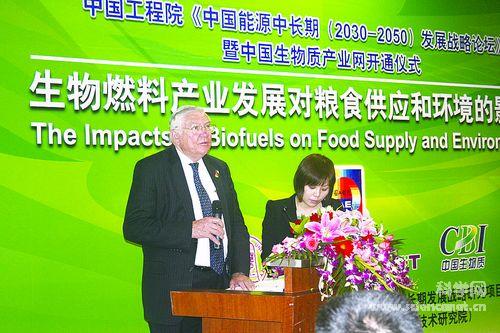
Dr Buchanan the Secretary of U.S. Department of Agriculture gave a speech
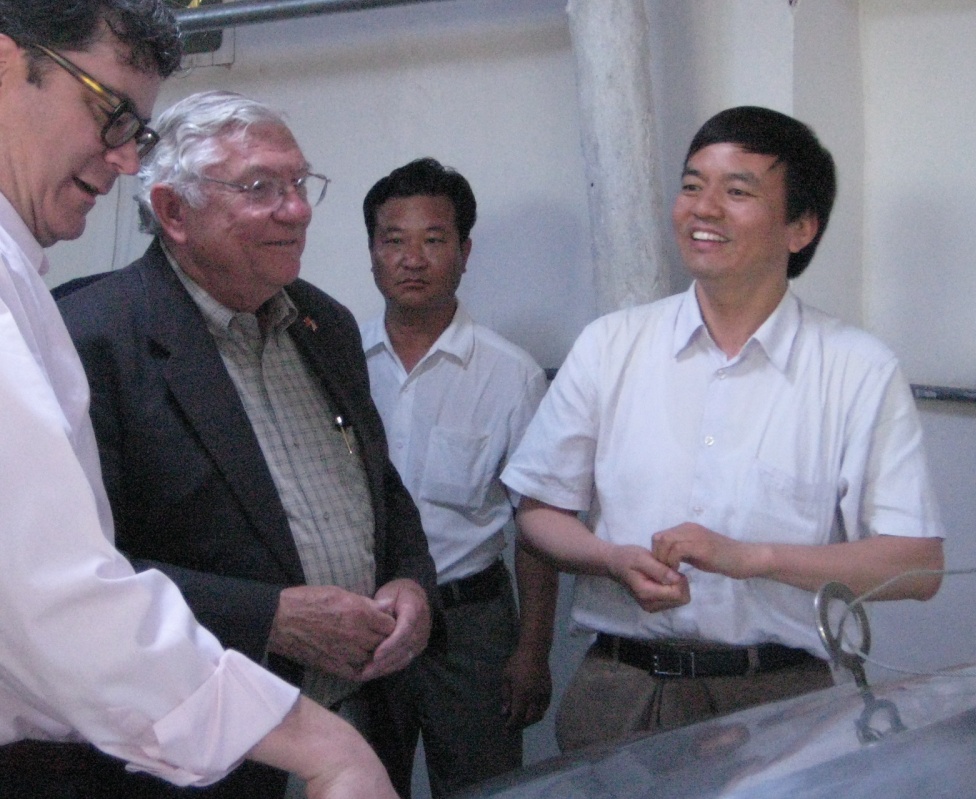
Prof. Shizhong introduced the sweet sorghum ethanol pilot plant for Dr Buchanan.
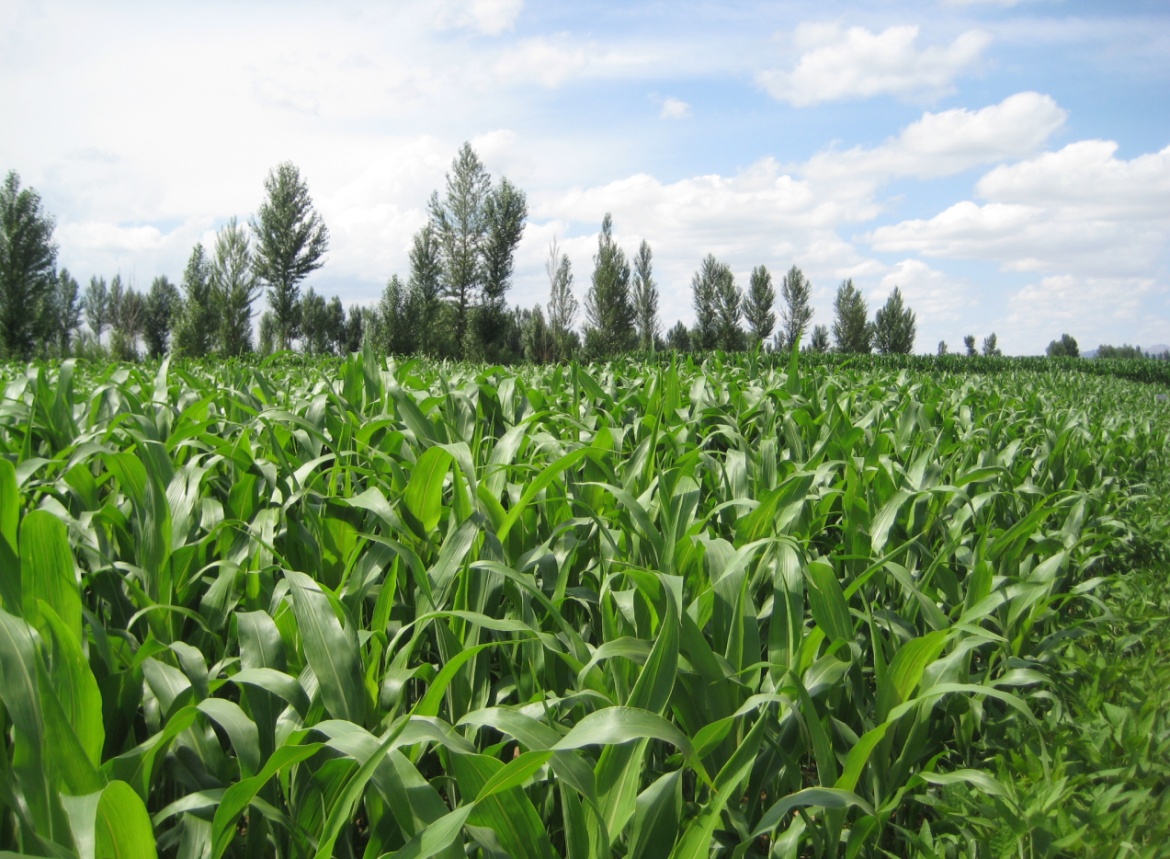
The production base for sweet sorghum ethanol in Inner Mongolia
Sponsored by the China Academy of Engineering and hosted by Institute of Nuclear and New Energy Institute, the “Long-term (2030-2050) Development Strategy Forum for Energy China” was held at Beijing UNIS Center on 10 July 2008. Experts from China Academy of Enigeering, China Academy of Science attended the forum. Speeches were made by U.S. Department of Agriculture (USDA) Secretary Dr Buchanan, Academician Prof Yuanchun Shi and Prof Shizhong Li from Tsinghua university.
Participants discussed on problems that may occur in China’s biofuel development. Dr Buchanan reported on U.S. biofuel target and policies, and expressed his interest in Chinese non-food ethanol technology, especially fuel ethanol production from sweet sorghum stalks developed by Prof Li. Prof Li explained on this in the later interview , “ Since World War II U.S. has already grown sweet sorghum on a large scale. However, Americans used to be proud on their abundant corn production but ignored the importance of non-food approach for ethanol technology, thus there has been a lag behind China.”
Under the substantial international criticism on fuel ethanol production from corn and wheat by U.S. and Brazil, especially some mass media which do not understand the mechanism yet deny bio-ethanol, Prof Yuanchun Shi said in all earnest that China’s biofuel was innocently influenced and at its toughest stage of development, and the meeting was of great significance.
In the “Agriculture, Farmers and Rural Area” issue, Prof Li considered biofuel sector played an important role, that only it could connect agriculture and industry together, and to completely solve farmers employment.
The USDA delegation led by Dr Buchanan visited the Pilot Plant of Prof Li’s laboratory located in Inner Mongolia after the conference. Prof Li highlighted the processing and operation of the pilot project. Dr Buchanan was interested in seeking further collaboration opportunity, by suggesting establishing a “Sino-US Joint Center for Biofuel Reseach”.
[5-7-2010] The Establishment of “Sino-US Joint Center for Biofuel Research” approved by University Council
On the 2009-2010 the 21st Tsinghua University Council meeting, Joint MOST-USDA Center for Biofuel Research was approved. The center is a non-entity research institution hosted at Institute of Nuclear and New Energy Technology, and commissioned by China Ministry of Science and Technology(MOST) and U.S. Department of Agriculture (USDA) as one of the forty international collaboration research center.
In August 2008, the former deputy secretary of USDA Dr Buchanan and the former Deputy Minister of MOST Yanhua Liu together signed an agreement for the center establishment for the purpose of strengthening collaboration between China and U.S. For nearly two years since then, the center has followed the trend for energy saving and emission reduction, and promoted sustainable renewable energy development. As a world-class biofuel R&D laboratory equipped with excellent research conditions and level, we have undertaken numerous national and international collaborated key projects, cooperating with academia and the industry.
VII. Pictures:
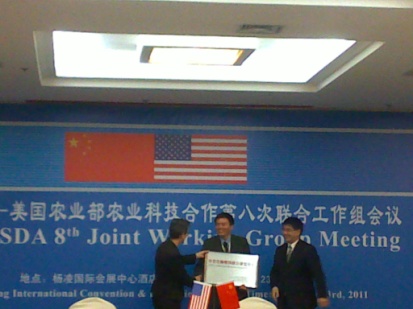
Nameplate Awarding by Deputy Directors Laiwu Zhang
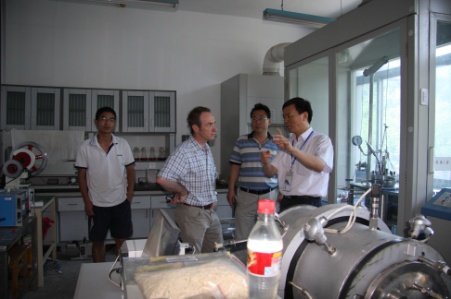
Nottingham University Vice-Chancellor Chris Rudd visited the laboratory.
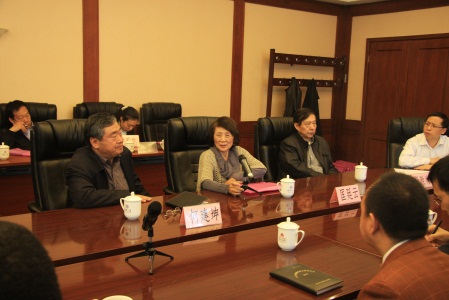
Steering committee composed by academicians and experts discussed over the research direction.
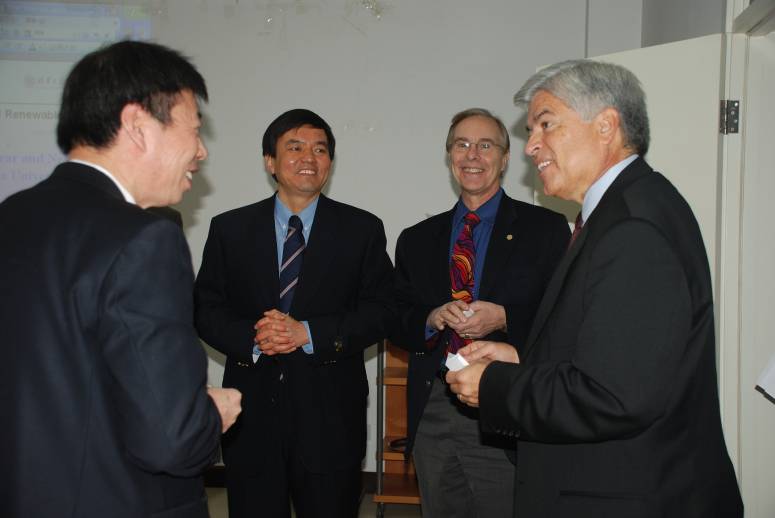
Dr Dan Avisu, the Director of National Renewable Energy Laboratory of U.S. Department of Energy visited the laboratory.
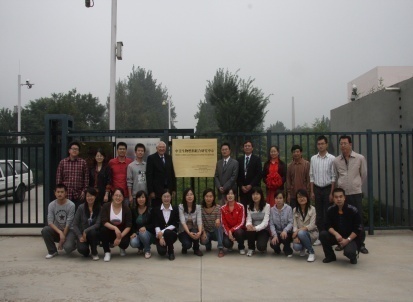
Former USDA deputy secretary Dr Buchanan and deputy secretary Yaping Tang unveiled the nameplate for the research center.

The Former U.S. President George H.W. Bush gave a high appraisal to ASSF technology.
Head of the division:
Prof. LI Shizhong
E-mail: szli@tsinghua.edu.cn